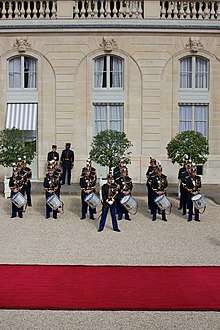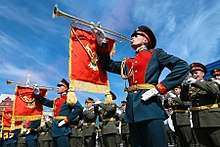Fanfare band
A fanfare band, fanfare corps, fanfare battery, fanfare team, horn and drum corps, bugle band, drum and bugle corps, or trumpet and drum band (including the German fanferenzug, fanfarenkorps and regimentsblaserkorps, the Dutch tamboerkorps, trompetterkorps and jachthoornkorps, the Turkish boru trampet takimi, the French batterie-fanfare and fanfare de cavalerie and the Italian batteria tamburi) is a military or civilian musical ensemble composed of percussion instruments, bugles, natural horns and natural trumpets (and sometimes even brass instruments). Fanfare bands are the descendants of the old medieval trumpet and drum teams that sounded fanfares on important occasions and are related to drum and bugle corps internationally.
.jpg)
Introduction and history
Fanfare Bands are a unique type of marching and military band that plays for entertainment, public occasions and gatherings as well as competing in various competitions. They evolved from the medieval ensembles of trumpets and drums, and in the ensembles of trumpets and timpani which were formerly common in the mounted bands of cavalry regiments.
Beginning in the late Middle Ages, trumpets and drums (usually snares and tenors) would sound fanfares to make important holidays or ceremonial events. These instruments would also serve as timekeepers in various towns, and announce various special events. Incorporated in mounted bands since the 12th century, timpani and trumpets or bugles were, from the middle of the 15th century, employed to motivate mounted troops in battle as well as on parade.

In the early 19th century, the natural horn came into being as a signalling instrument for the light infantry in France, Germany and the Netherlands.
The modern fanfare band first appeared during the 19th century, especially in Germany and France, but it is in Belgium where the first modern band was formed. Founded in 1806 at Izegem and currently known as the Koninklijke Stadsfanfaren Izegem (www.ksfi.be), it is the oldest and still performing Fanfare Band / Orchestra in the world.[1] At the same time, similar formations were also raised in the Netherlands. And by the late 19th century, fanfare bands became the official field music formation within the French, Dutch, Spanish, Italian, Turkish (Ottoman) and Belgian armies, with the bugle replacing the fife in the infantry and other arms (in the case of the Ottoman formations, replacing the centuries' old traditions of the Ottoman military band).
In the beginning of the 20th century, the French Republican Guard Band began developing its own fanfare and bugle section under its director Gabriel Defrance, thus the band and bugles of the French Republican Guard's infantry and cavalry units are the predecessors of today's ensembles. French civilian fanfare bands adopted similar styles at the same time, with the bands being located in civil fire departments, which were patterned in the traditions of the French Army and Navy and thus sported similar instruments. In 1935 the Band and Bugles of the French Air Force under Claude Laty, then the band director, further developed the modern fanfare band and its standard instrumentation as the band created its own fanfare and bugle section with Maurice Bonnard, the band drum major at that time. In Germany the use of fanfare ensembles was restricted to civilian bands from the late 19th century onward, although the fanfare trumpets survived in military bands till modern times, including until the 20th century, mounted bands. These civil bands form the basis of today's ensembles. In the late 20th century even the use of the shoulder strap and the introduction of valved bugles and multiple tenor drums from the US revolutionized the ensembles and the instruments they use. Today several ensembles in France and Germany use brass instruments in addition to the standard instrumentation as well as the multiple tenor drum.
Just as France started its modern fanfare band tradition, then came the formation of the French Fanfare Band Union (UFF) and the Sports and Culture Federation of France (FSCF) which became the governing authority for the civilian fanfare bands and handled their competitive and artistic aspects. Today, these two organizations, joined by two other associations formed in later years, jointly handle the administration, cultural and competitive duties of these bands.
Only a few bands are active in the Armed Forces of the Netherlands today, as well as the affiliated ensembles sporting similar instrumentation, due to budget cuts in the military. As in the case in corps of drums and pipe bands, like those in the UK, those in France are purely musical units in the HQ role in peacetime and with a combat role as assault pioneers or signallers.
Instrumentation

Fanfare bands are composed of the following instruments:[2][3][4][5][6][7]
- either single and/or multiple tenor drums (single tenors are standard use within the Netherlands, Germany and Italy)
- snare drums
- field snare drums (Tambours d'ordonannce in French)
- natural horns
- Cor de chasse (standard use in the Chasseurs Alpins)
- natural trumpets
- fanfare trumpets (chromatic and herald)
- Standard natural chromatic
- French Bass chromatic fanfare trumpet (Trompette basse, in French bands only)
- Fanfare trompette cor or fanfare trumpet horn (used in French bands, combines the tube of the natural chromatic fanfare trumpet/bugle with the features and bell of the natural horn/cor de chasse)
- Valved herald fanfare
- bugles
- including Bass bugles (Clairon basse in French, longer than standard bugles)
Sometimes added or serve also as permanent instruments in the fanfare band are:
- Bass drum/s
- Cymbals (especially clash cymbals)
- Timpani (especially in cavalry mounted bands)
- Glockenspiel
In concert configuration, the marimba, vibraphone, drum kit and other instruments may be used.
The group is usually led by either a drum major or a bugle major that coordinates the timing and speed of the music being played. Only several bands in Germany add the turkish crescent as part of the ensemble. In France and the Netherlands, they are sometimes paired with brass instruments and/or marching brass, and are led by a bandmaster (France only, optional in Dutch bands) with a drum major. These are:
- Trumpets
- Cornets
- Flugelhorns
- French horns
- Trombones (including bass trombones)
- Saxhorns
- Alto/tenor horns
- Wagner tubas
- Tubas, euphoniums, Baritone horns, sousaphones, helicons (the latter in mounted bands)
- Valved bugles used in United States drum and bugle corps:
- Soprano Bugles
- Alto bugles
- Flugelhorn Bugles
- Mellophones
- French horn bugles
- Baritone Bugles
- Marching Baritones
- Euphonuim bugles
- Marching euphoniums
- Contrabass bugles
Fanfare bands are sometimes paired with other marching musical ensembles of varying instrumentation or combined with a corps of drums composed of fifes, flutes, bugles, fanfare trumpets and percussion to form a type of massed field music unit and in several cases also paired up with brasses and woodwinds. They may also exist as a sub-unit of any of these ensembles.
Mounted fanfare bands
.jpg)
These bands employ brass instruments, timpani when mounted and marching percussion instruments when dismounted, glockenspiels, fanfare trumpets, core de chasse and natural horns. These military bands are meant for the cavalry, and only a few exist today in the armies of France, Peru, Bolivia and Argentina. In addition to the cavalry of the Republican Guard, the Armoured Cavalry branch of the French Army maintains a mounted fanfare detachment for ceremonial occasions - the same case in The Netherlands, which sports a dismounted brass band of this tradition in the Army, as well as another similar band in the Royal Marechaussee.
A few such bands today in Germany are only performing as dismounted civil brass bands, with some wearing period uniforms. However a revival of the practice is underway in Lower Saxony, Germany. A newly founded brass band, the Heidedragoner Brass Band, aiming to honor the legacy and traditions of the 16th (2nd Hannover) Dragoon Regiment of the Imperial German Army, got its horses and its very own drum horse in 2013 and when its mounted training was finished in 2016, it became Germany's first ever military styled civilian mounted brass band, the first ever to be organized in recent years, dressed in military-style uniforms.
The tradition of the dismounted fanfare band is also carried on by the Fanfare Band of the Royal Marechaussee in the Netherlands. A few veterans and reserve bands there hold on to the historic fanfare and bugle band traditions of the Dutch military.
See also
- Marching band
- Military band
- Fanfare orchestra for information on the brass band-styled ensembles used in the Netherlands and Belgium
- U.S. Army Herald Trumpets
- Corps of drums
- Drum and bugle corps (classic)
- Pipe band, Bagad
- Marching brass for detailed information on the valved bugles used in fanfare bands in several European countries
References
- 200 jaar Koninklijke Stadsfanfaren Izegem, written by the historian Jean-Marie Lermyte for Heemkundige Kring 'Ten Mandere', 2006
- http://asjnmusique.e-monsite.com/pages/les-instruments-de-batterie-fanfare.html
- http://trompettes1898.pagesperso-orange.fr/les%20instruments/les%20instruments.html
- https://eveil-romagnatois.fr/batterie-fanfare/
- http://bf-louhans-chateaurenaud.e-monsite.com/pages/instruments/essai.html
- http://fanfarenzug-strausberg.net/instrumente/
- http://www.musikzeit.info/instrumente/fanfarenzug.php
External links
| Wikimedia Commons has media related to Fanfare band. |